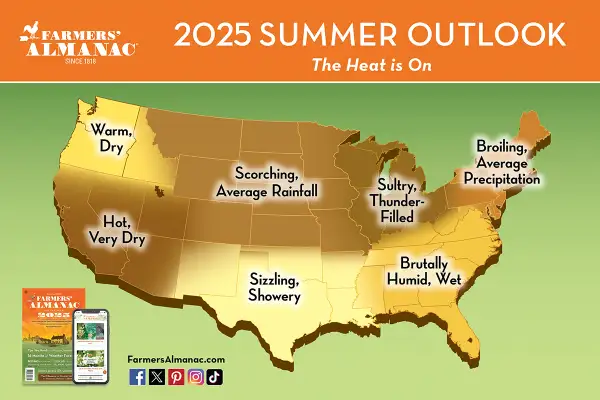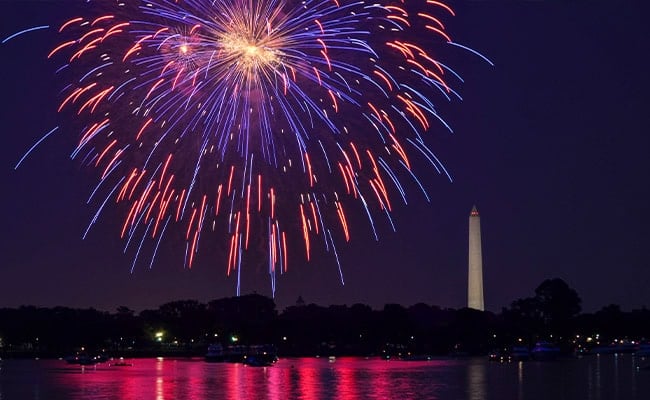Ready for a peek at summer weather 2025? Here is everything you need to know, including links to extended weather forecasts for your region! Questions about Farmers’ Almanac summer weather forecast or anything else? Drop a comment below …
The Heat Is On!
Summer officially starts with the summer solstice on Friday, June 20, 2025. Summer will arrive with unsettled to stormy conditions for most of the country, except the Atlantic Coast and Florida peninsula.
Heat will be in full force by July, with much of the nation sweltering with above- to high-above average temperatures. More long-time high temperature records may be broken this year.

Much of the country will see near-average precipitation, but the Far West will be drier than average, which could possibly lend itself to creating widespread wildfire activity.
However, it will be wetter than usual across the Southern Plains and Gulf Coast through Florida, due to frequent showery rains and thunderstorms.
In recent years, New England and the Northeast States have experienced abnormally wet summers. While there are occasionally heavy downpours predicted this summer, our long-range forecast points to a more typical amount of summer precipitation in these regions.

Fourth of July Forecast
Here are the Farmers’ Almanac 2025 weather predictions for Fourth of July weekend, July 4-7, 2025:
Zone 1 – Northeast & New England
New York, Vermont, New Hampshire, Maine, Massachusetts, Rhode Island, Connecticut, Pennsylvania, New Jersey, Delaware, Maryland, Washington D.C.
- Widely scattered showers, thunderstorms could hinder July 4th activities.
Zone 2 – Great Lakes, Ohio Valley & Midwest
Ohio, Michigan, Indiana, Kentucky, Illinois, Wisconsin:
- Severe thunderstorms sweep in from the west, perhaps threatening the Fourth of July holiday.
Zone 3 – Southeast
Tennessee, Virginia, West Virginia, North Carolina, South Carolina, Georgia, Alabama, Mississippi, Florida:
- Big thunderstorms TN, northern portions of MS, AL, GA, and the Carolinas could mar Independence Day activities.
Zone 4 – North Central
Missouri, Iowa, Minnesota, North Dakota, South Dakota, Nebraska, Kansas, Colorado, Wyoming, Montana:
- Severe thunderstorms, with possible tornado weather most of KS, MS, eastern parts of NE, through IA.
Zone 5 – South Central
Arkansas, Louisiana, Oklahoma, Texas, New Mexico:
- Severe thunderstorms; possible tornadoes OK; big thunderstorms TX, northeastward through AR, LA.
Zone 6 – Northwest
Washington, Oregon, Idaho:
- Unsettled conditions July 4th holiday.
Zone 7 – Southwest
California, Nevada, Utah, Arizona:
- Mixed clouds and sun; risk of a passing shower, thunderstorm.
Hurricane Outlook for The United States
During the second week of August, Farmers’ Almanac forecasts a possible hurricane threat for the Florida Gulf Coast, northeast to along the Southeast Coast. A second hurricane threat is forecast during the second week of September along the Atlantic Seaboard.

Labor Day Weekend Forecast
Here is are Farmers’ Almanac 2025 weather predictions for Labor Day, September 1-3, 2025:
RELATED: Why Can’t You Wear White After Labor Day?
Zone 1 – Northeast & New England
New York, Vermont, New Hampshire, Maine, Massachusetts, Rhode Island, Connecticut, Pennsylvania, New Jersey, Delaware, Maryland, Washington D.C.:
- Thunderstorms on Labor Day, then turning pleasant.
Zone 2 – Great Lakes, Ohio Valley & Midwest
Ohio, Michigan, Indiana, Kentucky, Illinois, Wisconsin:
- Fair weather for Labor Day.
Zone 3 – Southeast
Tennessee, Virginia, West Virginia, North Carolina, South Carolina, Georgia, Alabama, Mississippi, Florida:
- Thunderstorms clear Atlantic Coast, hopefully in time for Labor Day, then turning fair.
Zone 4 – North Central
Missouri, Iowa, Minnesota, North Dakota, South Dakota, Nebraska, Kansas, Colorado, Wyoming, Montana:
- Fair for Labor Day holiday.
Zone 5 – South Central
Arkansas, Louisiana, Oklahoma, Texas, New Mexico:
- Clearing skies for Labor Day.
Zone 6 – Northwest
Washington, Oregon, Idaho:
- Fair skies for Labor Day.
Zone 7 – Southwest
California, Nevada, Utah, Arizona:
- Fair weather for Labor Day activities.
Do you have any questions? Let us know in the comments below!
How About Summer Weather in Canada?
With the exception of the Atlantic Coast, the arrival of the summer solstice will start on an unsettled, if not a stormy note for much of the nation. Summer heat will arrive in full force by July with much of the nation sweltering with more than above-average temperatures.
As has been the case in recent years, some long-standing high temperature records may be broken. Much of the country will see near-average precipitation, but British Columbia and parts of Alberta will be drier than normal, which could possibly lend itself to widespread wildfire activity.

Hurricane Outlook for Canada
A hurricane threat during the second week of September could affect Newfoundland. From 2019 to 2023, there were an average of 21 named tropical cyclones. 2020 was the most active year on record with 30 named storms. And the past three years have seen Atlantic Canada exposed to significant tropical cyclone activity.
In 2023, the center of Hurricane Lee made landfall on Long Island, in Nova Scotia on September 16. Through the overnight hours into September 17, Lee traversed New Brunswick, Prince Edward Island, and Newfoundland before moving into the Northern Atlantic.
In 2022, The remnants of Hurricane Fiona remained intense, striking Nova Scotia on September 24 and extreme eastern Quebec on September 25. In Atlantic Canada, strong winds felled thousands of power lines and trees across the region, leaving over 500,000 customers without electricity and causing significant damage to roofs and windows in Nova Scotia.
Large waves and storm surge demolished more than 100 homes in southwestern Newfoundland and flooded many dwellings and businesses on the Magdalen Islands. Eight deaths were reported in Atlantic Canada, while insured losses alone reached $800 million, making the remnants of Fiona the costliest weather disaster in the region’s history.
In 2021, no fewer than three tropical systems affected the Maritimes and Newfoundland: Elsa, Ida and by far, the most potent, Larry which impacted Newfoundland on September 11th. High winds uprooted many trees, knocked down power lines, and damaged some roofs.
Almost 61,000 customers lost electricity, with most along the Avalon Peninsula. Damages assessed on Newfoundland were estimated at $80 million.
Typically, tropical cyclone activity over the Atlantic and Caribbean Sea increases precipitously during the second week of August and reaches its traditional peak on September 10 before declining rapidly after mid-October.
We hope this summer weather forecast and hurricane outlooks allow you to plan ahead and be prepared!
Join The Discussion
Are you looking forward to summer weather in 2025?
Share your thoughts in the comments!

I am making a good salary from home $4580-$5240/week , which is amazing under a year ago I was jobless in a horrible economy. I thank God every day I was blessed with these instructions and now its my duty to pay it forward and share it with Everyone,
Here is I started… . . . . . .>>> Www.Work44.Com